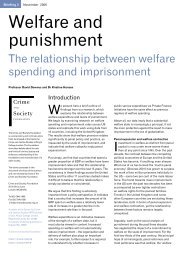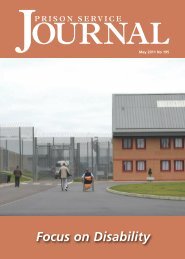PRISON SERVICE
PRISON SERVICE
PRISON SERVICE
- No tags were found...
You also want an ePaper? Increase the reach of your titles
YUMPU automatically turns print PDFs into web optimized ePapers that Google loves.
Prison staff occupational health and safetyand its relationship with inmate health:A reviewProfessor Michael W. Ross is based in the School of Public Health, University of Texas 1 .Introduction:Sharing Health Risks in PrisonPeople sharing an environment, even those withdifferent patterns of social structure andmovement, will also share many of the same healthand environmental risks. In a prison or jail context,therefore, there may be significant overlap in risks— and health protective factors — betweenprisoners and prison staff. In a close and closedcommunity, infectious diseases will spread withlittle distinction between the inmates and thecustodial staff. Further, where the environment isstressful, that stress will be manifested in both theinmates and the staff, and where it is unsafe, thelack of safety will extend to staff-prisoner as well asprisoner-prisoner interactions. In addition,environmental hazards will impact on both staffand inmates, whether through cold, heat, noise,poor ventilation, or environmental toxins such asasbestos or lead. Inmates and staff breathe thesame air, walk in the same buildings, touch thesame objects, and often suffer the same stresses ofthe psychological and physical environment.Sometimes they will eat food prepared in the samekitchens by the same staff or inmates. From aphysical and psychological health perspective, if aprison is an unhealthy environment for inmates, itwill also be unhealthy for staff. Thus, it makes nosense to consider the health needs of prisonerswithout realizing that in many instances, they areclosely connected with occupational health andsafety issues of prison staff, and vice-versa.Prison Staff as a Neglected Sector ofOccupational HealthIf prisoners can be considered a relativelyforgotten sector of the community, prison staff mightalso be considered a relatively neglected sector of theworkforce. The literature on the health andpsychosocial stressors of correctional staff is sparse,and staff in correctional institutions are oftenconsidered in conjunction with other peace officerssuch as police, although their duties and risks may varyconsiderably 2 . Part of this confusion may lie in the factthat in some occupational databases, no distinction ismade between police and correctional officers andthus occupational and lifestyle hazards in the twogroups cannot be separated. Further, as Jetté andSidney 3 observed, sometimes there is a traditionallyadversarial relationship between management andunions where there is a suspicion of any form oftesting of union members or their involvement inhealth-related or health-enhancement programs, and awariness that information collected might not be in thebest interests of their members. On the other hand,more recently other researchers have conducted largestudies in correctional systems with a high degree ofsupport and produced important findings that benefitboth management and staff 4 , 5 . All of these studieswere carried out in North America, although theyprobably generalize to other Western correctionalsettings.Long-term effects of Correctional System WorkOften, health issues of staff in the correctionalsystem focus on short-term risks to health such as traumaor infectious diseases. The long-term effects of working ina correctional setting should also be considered: however,such studies rely on following up large samples ofcorrectional staff over relatively long time periods, orlooking at measures or markers of morbidity incorrectional staff. Thus, they can be difficult andexpensive, or depend on the availability of large state ornational occupational data sets which distinguishcorrectional officers. When comparing mortality and1 . I thank Dr Amy Jo Harzke for her helpful comments on an earlier version of this paper.2. Hessl SM (2001). Police and corrections. Occupational Medicine 16(1):39-49.3. Jetté M, Sidney K (1991). The benefits and challenges of a fitness and lifestyle enhancement program for correctional officers. CanadianJournal of Public Health 82: 46-51.4. Armstrong GS, Griffin ML (2004). Does the job matter? Comparing correlates of stress among treatment and correctional staff in prisons.Journal of Criminal Justice 32:577-592.5. Alarid LF (2009). Risk factors for potential occupational exposure to HIV: A study of correctional officers. Journal of Criminal Justice37:114-122.Issue 192 Prison Service Journal55











